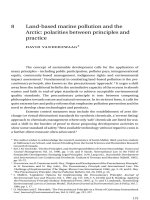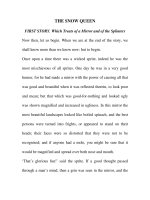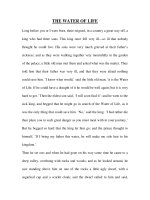The Water Soluble Vitamins: B and C
Bạn đang xem bản rút gọn của tài liệu. Xem và tải ngay bản đầy đủ của tài liệu tại đây (542.54 KB, 34 trang )
The Water Soluble Vitamins: B
and C
Chapter 10
Nalini Narahari
1
Overview of Vitamins
Vitamins are organic substances required in
minute quantities (micrograms to milligrams)
Vita means life; amine: nitrogen containing
The first vitamins discovered has nitrogen
Specific functions include:
Nurture growth; reproduction; maintain life
Prevent deficiency diseases
Do not provide energy;
Help the enzymes that release energy from the
carbs, fats and proteins
2
Cont.
•
Structure:
•
•
Food contents:
•
•
•
Individual units; not connected like molecules of
glucose, fatty acids and amino acids
Vitamins present in foods are ingested
Required in small quantities; measured in micro
grams and milligrams
Know the terms:
•
Bioavailability; precursors; coenzymes
3
Thiamin
Water
soluble vitamin
Part of the coenzyme, Thiamin Pyro
Phosphate (TPP)
Assists
in energy metabolism
Recommendations:
Men
1.2 mg/d;
Prolonged
The
1998 RDA
women 1.1 mg/d
deficiency leads to beriberi
custom of polishing rice in Asia
4
Cont.
Severe thiamin deficiency in alcohol abusers:
Wernicke- Korsakoff syndrome
Disorientation
Loss of short term memory
Jerky eye movements
Staggering gait
Food sources:
Whole grain, fortified and enriched products
Pork; ham
5
Riboflavin
Acts
as coenzyme in many metabolic
reactions
Flavin
Mono Nucleotide (FMN)
Stable when heated
Breaks down in light and radiation
Milk sold in opaque/translucent containers
Recommendations:
Men
1.3 mg/d
1998 RDA
women 1.1 mg/d
6
Cont.
Deficiency: Ariboflavinosis
Inflammation
GI tract
Food
of the mouth, skin ,eyes, and
sources:
Milk
and milk products
Enriched products
Liver
Canned clams
7
Niacin
Occurs as nicotinic acid and nicotinamide
Body transforms nicotinic acid to nicotinamide, a
major form of niacin in the blood
Body can make niacin from its precursor,
tryptophane
Stable in heat
Recommendations: 1998 RDA
Men 16 mg/d Women 14 mg/d
Niacin:lipid lowering function (niacin flush)
8
Cont.
Severe
deficiency leads to pellagra
Dermatitis
Diarrhea
Dementia
Food
sources:
Milk;
eggs, meat, poultry, fish,
Whole grains and enriched products
All protein containing foods
9
Biotin
As
a coenzyme plays a major role in
metabolism
Delivers a carbon to 3-carbon pyruvate:
formation of oxaloacetate to continue
with the TCA cycle
Stable to heat
1998 Adequate intake (AI)
Adults
30 micrograms/d
10
Cont.
Deficiency is rare
Can be induced by ingesting large quantities of egg
whites that contain avidin
Avidin is a protein in egg whites that bind biotin and
makes it unavailable to the body
About 2-dozen raw eggs!
Symptoms include skin rash, hair loss, and
neurological impairments
Food sources:
Organ meats, egg yolks, soybeans, fish, whole
grains
11
Pantothenic Acid
Part of many reactions in the synthesis of lipids,
neurotransmitters, steroid harmone and
hemoglobin
Unstable in heat
Destroyed by food processing
1998 AI: adults 5 mg/d
Deficiency is rare; “the burning feet”
Food sources:
Organ meats, mushroom, avocado, broccoli and
whole grains
12
Vitamin B6
Occurs in three forms
These forms can be converted to the coenzyme,
pyridoxal phosphate (PLP)
PLP can transfer amino acids, and thus body can
make nonessential amino acids
Alcohol interacts with Vitamin B6
Destroys and makes it unavailable to the body
The drug INH prescribed to treat tuberculosis acts
as an antagonist to the vitamin
B6 supplements are given to patients
B6 & carpal tunnel syndrome/oral contraceptives
13
Cont.
Recommendations:
Deficiency rarely occurs
Symptoms include depression, confusion
Toxicity first reported in 1983
Adults (19-50 years) 1.3 mg/d
Women taking more than 2 mg of B6/day (PMS)
Correlation between B6 and carpal tunnel syndrome
not conclusive
Food sources:
Meat, fish, poultry,legumes, non citrus fruits, liver
14
Folate (Folic Acid)
Involved in protein metabolism
Critical role in the synthesis of DNA
Involved in new cell development
Requires the help of the vitamin B12
Folate is secreted into the GI tract with bile
If the cells of the GI tract are injured/destroyed as
in the case of alcohol abuse, then folate can not
be absorbed, and leads to deficiency
15
Cont.
Unstable;
destroyed by heat and oxygen
Caution
with food processing, preparation
and storage
Recommendations:
1998 RDA
Adults
400 micrograms
The difference in bioavailability of folate
from food versus supplements considered
before setting the RDA for folate
16
Cont.
Deficiency leads to macrocytic or
megaloblastic anemia, and GI tract
deterioration
Diarrhea, fatigue, depression and confusion
Impairs cell division and protein synthesis
Alters DNA metabolism
Reported in babies fed on goat’s milk
Folate perhaps most affected by drug interaction
which has similar chemical structure
Can lead to secondary deficiency
17
Cont.
Cancer cells need folate to multiply;
Anti cancer drugs can create deficiency of folate
to other normal cells
Antacids
and aspirins interfere with folate
Smoking and oral contraceptives affect
folate status
Pregnant women are prone to folate
deficiency
Studies have documented the need for folate to
reduce the risks of neural tube defects
18
Cont.
FDA has mandated that grains should be fortified with
folate ( on the food label)
Folate and heart disease:
Research studies have identified the role of folate
in defending against heart disease
Folate deficiency may mask the vitamin B12
deficiency
Food Sources:
Fortified grains, green leafy vegetables(foliage),
legumes, seeds, and liver
19
Vitamin B12 Cobalamin
Close
relationship between vitamin B12
and folate
Depend
on each other for activation
Microwave
cooking destroys B12
Intrinsic factor:
The
HCL and pepsin in the stomach
release B12 from the protein foods to which
it is attached
20
Cont.
The
next step the intrinsic factor attaches
to B12
Then the whole complex passes to the
small intestine where the gradual
absorption of B12 occurs
Reabsorption of B12 happens continuously
Recommendations:
1998 RDA
Adults 2.4micrograms
21
Cont.
Deficiency caused by inadequate absorption
rather than poor intake
Lack of HCL or lack of intrinsic factor
Without HCL, the vitamin cannot be released from
protein, and cannot attach to intrinsic factor
Atrophic gastritis:
Commonly in older people, the stomach cells get
damaged
Could be due to iron deficiency or Helicobacter pylori
No healthy cells; No action of HCL and intrinsic factor
22
Cont.
Result is pernicious anemia due to a combination
of atrophic gastritis and lack of intrinsic factor
Other factors are defective gene for intrinsic factor,
or if the stomach is injured or damaged
In that case B12 must be injected
Nasal spray of B12; absorption is rapid
High dose of folate masks B12 deficiency
In both deficiency states, the first symptom is that
the blood cells grow rapidly
Either of the vitamins-supplement will be effective
23
Cont.
However if folate is administered when B12 is
needed, the situation will be disastrous
Results in devastating neurological symptoms
B12 deficiency leads to nerve damage caused by
destruction of myelin sheaths that protect the nerves
Note: folate can clear the blood symptoms but cannot
stop the nerve damage
Food sources:
Animal sources: meat, fish, poultry, eggs, shellfish,
milk/products, fortified cereals; soy milk with B 12
24
Non- B Vitamins
Choline:
Body
can synthesize; needed for the
synthesis of acetyl choline, a
neurotransmitter, and Phospholipid lecithin
Deficiency may cause liver damage
1998 AI men 550 mg/d; women 425 mg/d
Food sources;
Milk, liver,eggs and peanuts
25









